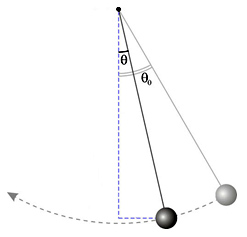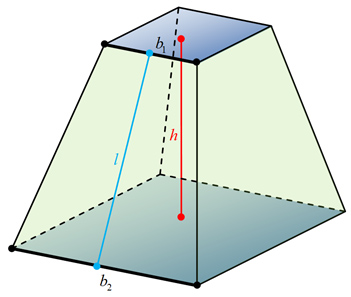The period of a pendulum is the time the pendulum takes to complete one back-and-forth swing. The period
T (in seconds) can be modeled by
T = 1.11√
1, where
l is the length (in feet) of the pendulum. If the length of a pendulum is halved, what happens to the period of the pendulum?

A. The period is also halved.
Incorrect. If you start with a length of 1 meter, the period would be 1.11. If the length is shortened to ½ meter, the period would be 1.11√0.5 = 0.78 ≠ 0.555.
B. The period is multiplied by a factor of √2.
Incorrect. If you start with a length of 1 meter, the period would be 1.11. If the length is shortened to ½ meter, the period would be 1.11√0.5 = 0.78. 1.11 × √2 ≈ 1.57. These obviously are not equal.
C. The period is multiplied by a factor of 
Correct!
D. The period is doubled.
Incorrect. If you start with a length of 1 meter, the period would be 1.11. If the length is shortened to ½ meter, the period would be 1.11√0.5 = 0.78.
A truncated pyramid's height,
h, and slant height l are related as shown in the formula:

b1 and b2 are the side lengths of the upper and lower bases of the pyramid, respectively.

If l = 6, b1 = 2, and b2 = 4, what is the height of the pyramid?

A
Correct!
B
Incorrect. You should have substituted the values l = 6, b1 = 2, and b2 = 4 into the formula and solved for h.
C
Incorrect. You should have substituted the values l = 6, b1 = 2, and b2 = 4 into the formula and solved for h.
D
Incorrect. You should have substituted the values l = 6, b1 = 2, and b2 = 4 into the formula and solved for h.
The speed v (in meters per second) of sound waves in air depends on the temperature K (in Kelvins), modeled by the equation  . Kelvin temperature K is related to Celsius temperature C by the formula K = 273.15 + C. Celsius temperature is related to Fahrenheit temperature by the formula
9
5
C + 32. If the sound waves are traveling 300 m/s, find the temperature in Fahrenheit.
. Kelvin temperature K is related to Celsius temperature C by the formula K = 273.15 + C. Celsius temperature is related to Fahrenheit temperature by the formula
9
5
C + 32. If the sound waves are traveling 300 m/s, find the temperature in Fahrenheit.
A. 223.71 degrees
Incorrect. This is the temperature in Kelvins.
B. -57 degrees
Correct!
C. -49.44 degrees
Incorrect. Convert from Celsius to Fahrenheit.
D. 165.67 degrees
Incorrect. Check the speed substituted in.
The maximum horizontal distance d (in meters) that an object can travel when launched at an optimum angle of projection is given by d =  , where h0 is the object’s initial height, v0 is the initial speed, and g is the acceleration due to gravity. If an object is launched with an initial height of 3 meters, what initial velocity would produce a distance of 1 km? (Remember, 1 km equals 1000 m.)
, where h0 is the object’s initial height, v0 is the initial speed, and g is the acceleration due to gravity. If an object is launched with an initial height of 3 meters, what initial velocity would produce a distance of 1 km? (Remember, 1 km equals 1000 m.)
A. 98.8 m/s
Correct! Did you solve the equation graphically, with a table, or algebraically?
B. 439.2 m/s
Incorrect. Check your formula.
C. 30.8 m/s
Incorrect. You used 100 m instead of 1000 m.
D. 1.26 m/s
Incorrect. Did you try to solve the equation graphically, with a table, or algebraically?





 . Kelvin temperature K is related to Celsius temperature C by the formula K = 273.15 + C. Celsius temperature is related to Fahrenheit temperature by the formula
. Kelvin temperature K is related to Celsius temperature C by the formula K = 273.15 + C. Celsius temperature is related to Fahrenheit temperature by the formula
 , where h0 is the object’s initial height, v0 is the initial speed, and g is the acceleration due to gravity. If an object is launched with an initial height of 3 meters, what initial velocity would produce a distance of 1 km? (Remember, 1 km equals 1000 m.)
, where h0 is the object’s initial height, v0 is the initial speed, and g is the acceleration due to gravity. If an object is launched with an initial height of 3 meters, what initial velocity would produce a distance of 1 km? (Remember, 1 km equals 1000 m.)